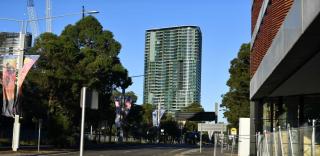



An interim engineering assessment released yesterday indicates concrete panels cracked due to their manufacture and assembly deviating from the original design. Though the building is structurally sound and in no danger of collapse, repairing the faults will be costly, slow and disruptive to residents.
The tower's size, age (it is less than six months old) and the timing of its cracks might have made it particularly newsworthy, but badly built apartment blocks are far from unusual. Right now across Australia's cities many buildings have significant leaks, cracks and fire safety failings.
So we can't just address faults in individual developments. We need to identify the systemic flaws in how "compact city" policies have been planned and implemented.
The consequences of these flaws increasingly affect us all.
As the population of Australia's capital cities grows, more of us are living in apartments. Governments have been promoting greater housing density as an alternative to sprawl for decades. But they haven't always ensured this density has been done well, including in terms of building quality.
Space to play or pause, M to mute, left and right arrows to seek, up and down arrows for volume.
In the aftermath of the Opal Tower saga, experts have pointed to many reasons why building defects can occur.
These include the fact that developers owe buyers few legal obligations once the apartments are sold, which limits their risk if they get things wrong. There are also significant market pressures, particularly in boom times, to build quickly and cheaply. And there are gaps in how the construction process is overseen, meaning errors go unnoticed.
These are not new observations, but getting regulations in place to address them has proven challenging. A case in point is NSW's new defects bond, requiring developers to put aside 2 per cent of the building value to fix defects down the track. The bond's introduction was delayed for years, and it will be a few more years yet before we know if it works.
So just how severe is the situation? Right now, we don't know for sure.
In 2012 a City Futures Research Centre project surveyed apartment owners in NSW. Out of more than 1,000 respondents, 72 per cent knew of defects in their strata-title complex. Among those whose apartments had been built since 2000, the percentage was 85 per cent.
That project only looked at building defects as one of a number of issues facing apartment owners, however, so it didn't document the issue in detail.
Our new research project will examine just how prevalent building defects are, the reasons they occur, and how strata-titled housing can be improved.
While the research will focus on Sydney, we hope it is a step towards changing planning and development policies to ensure better quality apartment buildings nation-wide.


